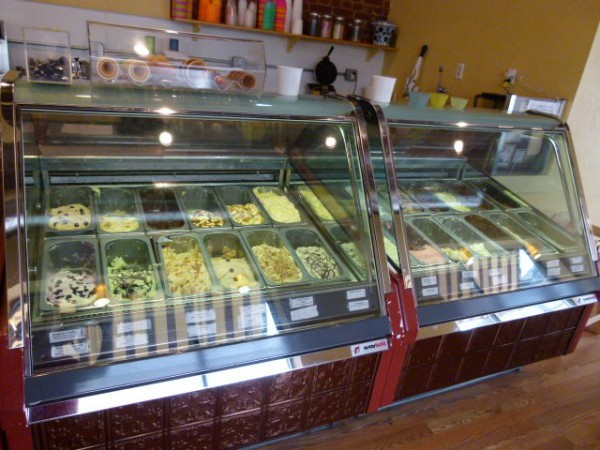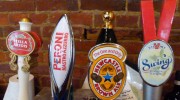Flour Power: From Lou’s Bar to Mercurio’s Pizza, The Turning Of A Shadyside Corner
- Like
- Digg
- Del
- Tumblr
- VKontakte
- Buffer
- Love This
- Odnoklassniki
- Meneame
- Blogger
- Amazon
- Yahoo Mail
- Gmail
- AOL
- Newsvine
- HackerNews
- Evernote
- MySpace
- Mail.ru
- Viadeo
- Line
- Comments
- Yummly
- SMS
- Viber
- Telegram
- Subscribe
- Skype
- Facebook Messenger
- Kakao
- LiveJournal
- Yammer
- Edgar
- Fintel
- Mix
- Instapaper
- Copy Link

L. to r., managers Brandon Beatty and Alex Cromer with Anna and Michael Mercurio and some of their favorite gelato flavors..
5523 Walnut St.
Shadyside
(412) 621-6220
www.mercuriosgelatopizza.com
FARE: Artisan Gelato/Authentic Neapolitan Pizza
ATMOSPHERE: Contemporary Tuscan Cucina
PRICE: Pizza, $6-$16/Gelato $.70 cents per ounce
HOURS:
Sun. & Mon., 1-9 p.m.
Tues. thru Thurs., 11 a.m. – 10 p.m.
Fri. & Sat., 11 a.m. – 11 p.m.
Remember:
No reservations
Credit cards accepted.
Sample menu available on website
Take-out option
Corkage Fee $7
Wheel chair accessibility
(Ratings are 0-4 stars)
Walking past the corner of Walnut and Filbert streets in Shadyside, I sometimes drift into a netherworld of ghosts and personal memories. Years ago, Lou’s Shadyside Bar and Grill, colloquially known as “Lou’s,” was a saloon on the retail level of a Victorian building at this vibrant corner. After dark, when the shopping crowd had gone home and the awnings were drawn, a new sub-culture took over. People threaded their way in and out of clubs and restaurants, a world unto itself along the busy avenue. Music was everywhere, driving the rhythms of life—in corner pubs, posh nightclubs, and seamy after-hour spots. I worked the late-night shift at Lou’s for almost a decade and knew every inch and cubby, every lover’s hideout and mouse’s hole.
Today, after many incarnations, Mercurio’s—a sparkling Neapolitan pizza and gelato restaurant—occupies the same space where Lou’s once flourished. Dabbing at my strawberry-cheesecake gelato, I drift back to my first week working behind Lou’s bar. I have to admit that, in those days, I knew more about the mathematical proofs for the existence of black holes than I did about Steelers’ defensive tackle Mean Joe Greene. When he sat on a barstool one day, I perceived an enormous, charismatic man who was easy to talk to. We carried on a lengthy conversation, and when he left, the regulars mobbed me. “Wha’d he say?” “Wha’d ya talk about?” “Wha’d he tip?”
“Who IS he?” I yelped. But I learned. Here’s a look at how it all began.
LOU’S SHADYSIDE BAR & GRILL, CIRCA 1980’S
I had never done more than steal a cursory glance through the front door until one sweltering summer night on my way home from my job as a short-order cook when I impulsively dropped in for a cocktail.
“Shot and a beer…down the street for a frou frou drink,” squawked Noreen, the waitress, waking me from my reverie and, for a second, obliterating my image of Lou’s as a friendly neighborhood tavern. Beer it was. I slouched into a hard-backed chair and shimmed a wobbly table leg with a pack of matches. It was hard to see in the dim light.
It was the early 1980s. Disco was waning, the Sony Walkman was cutting-edge technology, and counter-cultural retail was well beyond passé. Anyone familiar with present-day Shadyside may require divine intervention to be convinced that there wasn’t a chain store in sight. Intact from the days of thick gray air and thirsty millworkers, Lou’s, next door to Prantl’s Bakery (still in operation) and across the street from Noah’s Waterbeds (long gone), had a grand set of bones, compromised by an ever-present shroud of smog and residue deposited by the dragons of steel.

Mercurio’s and Prantl’s, new and old Shadyside side by side.
Sad and sour during the day, the establishment sagged with old-timers, bakers getting “off-shift,” and a few dispossessed souls, all tended to by “Babe,” a tiny, thin-framed 80ish gentleman in a crisp white shirt and bowtie. Babe perpetually polished stemware as if the Gipper and his Four Horsemen were expected momentarily. Patrons took refuge at a long, expansive bar that could have been extracted from Edward Hopper’s painting, “Nighthawks,” with a defiant minority seeking refuge in well-worn, red vinyl booths. A surreal ambient glow permeated the interior. With smoking still the horse to a libation’s carriage, the walls had acquired the patina of a brown egg.
Put the moon into this picture, and Lou’s morphed into a funky, bohemian club typical of New York’s fabled West Village or San Francisco’s Haight Asbury. A magnetic swirl of youngish humanity ignited the avenue and surged inside.
Noreen, the waitress, immediately spied my rolled-up apron and gave me the inside track. “We’re sorta in between kitchens,” she whispered when I asked for a menu. On her next pass, she dropped off a bowl of beer nuts and confided: “The owner keeps a frozen hamburger patty in a downstairs freezer, his idea of satisfying local Health Department regs, qualifying us as a legitimate bar/food service establishment.”
Just as I’d begun casting off the day’s troubles, there was a fuss at the bar. Noreen tore off her apron and huffed outside, slamming the side door with a force that could have registered a “5” on the Richter scale. By the time I left an hour later, Noreen was back, my brew had been comped, and Nick, the owner, had offered me a bartending job.
I had never poured a beer in my life. No kidding. But Nick assured me that all I needed to know was “that a boilermaker at Happy Hour is two shots with a beer chaser, $1.25.” With trepidation, I relinquished my title as “Milkshake Queen” and accepted Nick’s offer.
Nick was no managerial genius, but like a broken clock, he occasionally got it right. One of his brainstorms was to build an elevated stage resembling an indoor tree house “erected with a degree of craftsmanship that clearly illustrated the need for fire, safety, and building codes,” muttered Mr. Dish, who would eventually become my husband. He should know, because he moonlighted as a drummer in the house band StreetPlayer while earning an MBA at Pitt. The stage quickly became a local legend, its permanency the subject of a betting pool. Regulars became obsessed with making side bets as to when the stage would collapse. Fortunately for the performing musicians and pinball players below, the bookmakers never had to cover those wagers.
I survived a few fake bomb threats, the crazy suspended stage, and a nonstop parade of colorful customers who traversed the gamut of wanting to kiss or kill me, depending on the night. One summer, my most unexpected regular was a nine-foot gorilla mannequin that appeared atop the bar, on loan from Nick’s friend, who had inherited it from a funhouse. Then, fellow bartender Dennis tapped his glass and hoisted me into its furry arms, a la Fay Wray, and a summer institution was born. Thereafter, the crowd took over, each night clamoring for the “gorilla toast.” Around midnight, I was routinely plucked from the floor to quell the chants and, within moments, ingloriously returned to bartending duties, scurrying about, serving a jammed house.
MERCURIO’S April 2011 – Current ***
Fast forward to here and now. Enter Mercurio’s, the ingénue at 5523 Walnut Street. The corner has never looked so good. The building’s exterior is reminiscent of San Francisco’s painted ladies, though not as giddy. Outdoor café tables, a bench, and a few potted plants give the Filbert Street side curb appeal, and the contemporary interior is full of one thing Lou’s never had—sunlight.

Comfortable and bright, Mercurio’s interior
By May of 2011, Mercurio’s, a sublime, artisan gelato shop, began operations in this locale. Initially, its effortless minimalism, all room and open counter, was the by-product of city codes. “When we started out, there was no pizza, only gelato,” confirms co-owner Michael Mercurio. “We weren’t permitted by the city to have indoor seating, since we hadn’t yet met building code.” The room’s vastness dwarfed the spotless stainless gelato case in the back of the house. Selecting gelato was, and still is, a simple procedure: dawdle a bit in front of the counter, let your eyes roam over 40 selections (out of a possible 200 flavors), maybe ask for a taste. The creamy, light “Italian ice cream” is low in butterfat (7 percent vs. ice cream’s 10-16 percent) but every bit as fine as the best fare. Mercurio’s gelato has a dense, dreamy texture, sans the tons of air American manufacturers pump into theirs.
Behind the scenes is the big Mercurio family, headed by father Richard and mother Linda. Michael and Anna, kids number five and six, respectively, from a brood of seven, are the store’s co-owners. The family’s first foray into the gelato business started out with Mulberry Street Creamery, established in nearby Kittanning during 1997. Vertical integration was later achieved with the creation of their first retail outlet, Mercurio’s Mulberry Creamery (2006-10), housed in a tiny nook above Girasole restaurant on Copeland Street in Shadyside. “I’ve been scooping gelato since I was 11,” laughs Michael, who remembers his mother taking him and his siblings to work with her when they were just kids. “Mom still owns and oversees the original Kittanning plant, where all of our gelato is still made, with milk from local, grass-fed, hormone-free cows.”

Two cases of flavorful Gelato
“Dad came up with the base recipe after searching the world over, with Mom,” chimes in Anna. The authentic flavor replications blow me away, flavors like Girl Scout Cookie, Birthday Cake, Pistachio, Chocolate Marshmallow, Death by Chocolate, and, my personal favorite, Coconut Crème Pie. Now that summer is hovering, try a tart lemon sorbet.
“The day I didn’t get selected for the Marines,” recollects Michael, “my mom said, “Let’s do this pizza we’re always talking about.’”
If you’ve never been in the restaurant business, starting out is a guaranteed ‘baptism by fire,’” says Michael. “ I wanted to be an entrepreneur from the ground up.” His exposure to the pizza business began with a brick oven his Dad built in the family’s backyard. Formal training continued in Greenwich Village’s famed Kesté, a famous Neapolitan house that offers certification in Neapolitan technique, including a special “hurricane” method for hand-stretching dough that dates back to Queen Margherita (Queen from 1878-1900).
Hubristic New Yorkers may think they invented thin-crust pizza, but historically it originated in Naples (Italy). Mercurio’s is a worthy synonym. The best Neapolitan-style crust is designed to be very light, and less doughy than what Pittsburghers may be used to. “I push the air towards the crust,” says Michael. “If you’re good at this technique, you get a little texture, a micro-layer of crunch, and it’s a little chewy, too.”
Today the massive, wood-fired pizza oven consumes most of the back of the house, along with a curving, suspended exhaust armature that creates a quirky, Calderesque mood.
The most obvious cultural touchstones in Mercurio’s Neapolitan technique are also evident in the finest quality ingredients, made in house, from scratch, starting with superfine Caputo “OO” flour imported from Italy. “They mill it differently, a super soft, ground-to-a-powder flour, with low gluten content. The quality and consistency is unmatched.” One particular night, in seats right by the open cucina, my husband and I watched the chefs in T-shirts and flour-dusted aprons shovel pizzas in and out of the oven. A pie bakes in only a minute or two, at 1,000 degree F.

Authentic,wood-burning pizza oven.
It’s this short baking time that brings out its authentic tastes, smells, and texture. The clean, pristine Regina Margherita, with a judicious swirl of red sauce, plays nicely against house made mozzarella and freshly snipped basil creates the pizza’s own gastronomic Italian flag. I love how basil changes the entire character of the pizza, with its pungent, garden-sweet aroma. “Tomato, basil, spices, and a few secret ingredients,” winks Michael. By the way, there is no pepperoni in the store (Mercurio’s uses paper-thin prosciutto, replicating the predominant practice in Italian pizzerias).
That said, if you like a thick-crust from Chicago or a pie sagging with toppings, you may be stepping out of your comfort zone.
Pizzas at Mercurio’s are all one size, officially around 10 ½ inches in diameter, about the size of a dinner plate. Cut into four slices (eight, if requested), the simple house Marinara pizza, as basic as they come, says it all: a beautifully rich pie without being overpowering, with an overall golden sheen to a crust that is very light, with an ever-so-slight “chew” and a reliable crackle when you take that first bite. Good walking food, “on the fly,” or “libretto.”
Slight char prints on the crust’s underside add another earthy dimension. And the judicious application of fresh mozzarella and a balanced, lush tomato sauce made from San Marzano tomatoes—grown near the base of Mt. Vesuvius, where volcanic ash fertilizes the land—comprise key components designated as “proper” for Neapolitan pizza. Primavera Con Carne is another good option, with fresh artichoke, mushroom, and roasted red pepper; the chef coaxes the innate flavors from veggies without over-roasting them.
Justin, our server on several visits, is consistently upbeat, energized, and always ready with a suggestion when asked. He turned us on to Pizza Del Re, a unique, inspired pie, with all of the expected goodies plus a truffle spread that renders a slightly peppery, musky sensation, superb with mushrooms and some spicy hot prosciutto di Parma for contrast.

Pizza served tableside with water and wine.
If, in a rare moment, you’re not in the mood for pizza, the menu is tightly edited with three smaller categories: antipasti, insalate, and panini. Even though some say “caprese” is on the way to being ubiquitous (remember portobello mushrooms), I personally never tire of it. The soft mozzarella, curled up like an elf’s slipper, is some of the best I’ve had, decked with sliced tomatoes, basil, and the house’s perfect-pitch balsamic reduction. Mr. Dish and I also enjoyed a Rustica salad, a restorative spring mix with salty prosciutto, tasty artichokes, gaeta olives, and grape tomatoes, all dressed in the same, inspired balsamic vinegar. Extra virgin olive oil seems ever the more fine when poured from a fancy copper teapot.

Insalate Rustica
Liquor licenses are rare in most pizza parlors, but Mercurio’s has one, a 20-deep list of red and white wines, by glass or bottle, with four beers on tap, including a seasonal rotation and Peroni, an intensely fresh, crisp Italian lager.

Mercurio’s Beers on Tap
This working-class corner tavern in Shadyside has, over the decades, sold chocolate and baby clothes, been a back store and a health spa, and was a hair salon, twice. These days, it seems to have found its stride as the fanciful, modern Mercurio’s.
Sitting next to the imported ceramic pizza oven—in the place where Lou’s rickety stage used to be, where I met my husband, learned to make a perfect Manhattan and a mean Bloody Mary—I can still imagine the pre-chain store, dancing-in-the-streets Shadyside. A cacophony of musical styles faded in and out as one progressed down the street, like adjusting the dial on an FM radio band, bopping from one station to another. It’s a good corner, and Mercurio’s continues some rich traditions, carrying the torch with grace and style. I like to imagine all of the kids (now and in the future) ruminating about their days sitting at these tables, pecking away on laptops, chatting on cell phones, maybe tangling their feet with someone else’s, all eating pizza and trying to leave enough room for some knock-out gelato.
Deborah McDonald is a Pittsburgh native who worked in the local food and hospitality industry (dropping many a plate and glass) while earning her degree in journalism. McDonald is one of Pittsburgh’s most respected and experienced food and restaurant writers.
Photos: Rick Handler
Share on Social Media
- Like
- Digg
- Del
- Tumblr
- VKontakte
- Buffer
- Love This
- Odnoklassniki
- Meneame
- Blogger
- Amazon
- Yahoo Mail
- Gmail
- AOL
- Newsvine
- HackerNews
- Evernote
- MySpace
- Mail.ru
- Viadeo
- Line
- Comments
- Yummly
- SMS
- Viber
- Telegram
- Subscribe
- Skype
- Facebook Messenger
- Kakao
- LiveJournal
- Yammer
- Edgar
- Fintel
- Mix
- Instapaper
- Copy Link
Follow Entertainment Central
Sign up for the EC Newsletter
Latest Stories









